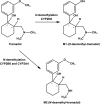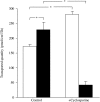Uptake/efflux transport of tramadol enantiomers and O-desmethyl-tramadol: focus on P-glycoprotein
- PMID: 19496778
- PMCID: PMC2774482
- DOI: 10.1111/j.1742-7843.2009.00428.x
Uptake/efflux transport of tramadol enantiomers and O-desmethyl-tramadol: focus on P-glycoprotein
Abstract
The analgesic effect of tramadol (TMD) results from the monoaminergic effect of its two enantiomers, (+)-TMD and (-)-TMD as well as its opioid metabolite (+)-O-desmethyl-tramadol (M1). P-glycoprotein (P-gp) might be of importance in the analgesic and tolerability profile variability of TMD. Our study investigated the involvement of P-gp in the transepithelial transport of (+)-TMD, (-)-TMD and M1, using a Caco-2 cell monolayer model. The bidirectional transport of racemic TMD and M1 (1-100 microM) across the monolayers was investigated at two pH conditions (pH 6.8/7.4 and 7.4/7.4) in the presence and absence of P-gp inhibitor cyclosporine A (10 microM) and assessed with the more potent and specific P-gp inhibitor GF120918 (4 microM). Analytical quantification was performed by liquid chromatography coupled to the fluorescence detector. A net secretion of (+)-TMD, (-)-TMD and M1 was observed when a pH gradient was applied (TR: P(app)(B - A)/P(app)(A - B): 1.8-2.7; P < 0.05). However, the bidirectional transport of all compounds was equal in the non-gradient system. In the presence of P-gp inhibitors, a slight but significant increase of secretory flux was observed (up to 26%; P < 0.05) at both pH conditions. In conclusion, (+)-TMD, (-)-TMD and M1 are not P-gp substrates. However, proton-based efflux pumps may be involved in limiting the gastrointestinal absorption of TMD enantiomers as well as enhancing TMD enantiomers and M1 renal excretion. A possible involvement of uptake carriers in the transepithelial transport of TMD enantiomers and M1 is suggested.
Figures




References
-
- Schenck EG, Arend I. [The effect of tramadol in an open clinical trial (author’s transl)] Arzneimittelforschung. 1978;28:209–12. - PubMed
-
- Lehmann KA. Tramadol for the management of acute pain. Drugs. 1994;47(Suppl 1):19–32. - PubMed
-
- Savoia G, Loreto M, Scibelli G. [Systemic review of trials on the use of tramadol in the treatment of acute and chronic pain] Minerva Anestesiol. 2000;66:713–31. - PubMed
-
- Scott LJ, Perry CM. Tramadol: a review of its use in perioperative pain. Drugs. 2000;60:139–76. - PubMed
-
- Lintz W, Erlacin S, Frankus E, Uragg H. [Biotransformation of tramadol in man and animal (author's transl)] Arzneimittelforschung. 1981;31:1932–43. - PubMed
Publication types
MeSH terms
Substances
LinkOut - more resources
Full Text Sources
Other Literature Sources
Miscellaneous

